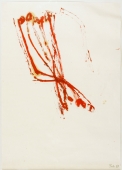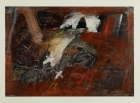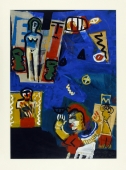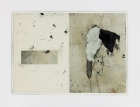
Artist | Stephan Melzl (*1959)
https://www.artist-info.com/artist/Stephan-Melzl
 Artist Portfolio Catalog
Artist Portfolio Catalog
| Image | Artist | Title | Year | Material | Measurement | ||||||||||||||||||||
|---|---|---|---|---|---|---|---|---|---|---|---|---|---|---|---|---|---|---|---|---|---|---|---|---|---|
 |
Stephan Melzl | "Ohne Titel" | 1995 | oil on Xerox paper on plywood | 42 x 29,7 cm | ||||||||||||||||||||

Stephan Melzl (*1959)"Ohne Titel"
|
|||||||||||||||||||||||||
 |
Stephan Melzl | untitled | 1990 | oil on resin on paper and plywood | 38 x 50 cm | ||||||||||||||||||||

Stephan Melzl (*1959)untitled
|
|||||||||||||||||||||||||
 |
Stephan Melzl | untitled | 1992 | oil on blue paper on plywood | 86 x 61,5 cm | ||||||||||||||||||||

Stephan Melzl (*1959)untitled
|
|||||||||||||||||||||||||
About the work (english)
About the work (english)
Born in 1959, Stephan Melzl draws a lot. In his studio there are heaps of pencil drawings, drawings to which he pays no further attention. He draws swiftly, expansively and with a certain hand. The lines search and delimit; they do not aim to create a drawing, but instead to address an idea. Stephan Melzl impatiently nourishes the diffuse to the point when he simply has to pick up a brush. When he produces his obsessive structures by putting oil to colored Xerox paper, nothing indicates that each of these structures has been preceded by countless sketches. Now I may be using the word "sketches " here. But I think that Stephan Melzl's sketches are more than mere outlines of ideas. They are drafts, albeit not complete drawings. That is not something Melzl strives for. The paintings are small in size and precise; in terms of meaning they are, however, themselves diffuse: organic, liquid, and stretchable quantities intermixed with nooses and acts of devouring - yet again, the devouring becomes an act of turning inside out or turning over, a choking and a vomiting. Nothing trickles or runs away. The organic, liquid and stretchable, is ensnared toughly and yet malleably in a lascivious fleshy wrap of impassable bends and wind.
That probably sounds as if Stephan Melzl gets lost in the "entrails". That is most certainly not the case. What is decisive in his work is his vantage point "outside". It is a point of view that locates the organic construct with great precision in an everyday setting of perception.
The organic constructs increasingly become sexual. Stephan Melzl's pictures are metaphors for obsessions, Melzl diagnoses that the body of society is obsessive: it is a body that examines itself, that contemplates its own navel, that brings forth symptoms comparable to those of the individual. Stephan Melzl speaks of an implosion of feelings and patterns of thought as a system that continually generates itself autoerotically. Somebody says: "I find these pictures repulsive." And I would add: "Fascinatingly repulsive," in order to emphasize the double bind involved, according to which "I want out but I also want to stay in."
Stephan Melzl pin-points the social addiction precisely at that juncture where it becomes directly visible: The effect of the cigarette on the gums and the tongue, the impact of the capsule where it starts to seize hold of us. Cigarette and capsule resemble intimate pierced jewelry in the form of a pendant sinker or a pacifier (lollipop), which "earths" or "mobilizes" the female genitals. In portraying sexual intercourse the camera unites the act of seeing and the seen. In 1982 Eric Fischl painted a triptych (Inside out, 1982), in the left section of which a couple making love watch a TV movie or porno film. A penis lusts in a contraceptive, the "moist gliding wrap" of which is both the point of contact and the point of friction. Testicles hang like the weights on the end of curtain sashes or like something bulging out of a burst egg, as if the only thing involved was to weigh these things in your hand.
The autoerotic system, which Stephan Melzl presents to us, borrowing freely from Michel Carrouges’ Bachelor Machine (1954) is the radicalized, meticulously painted process of everything becoming independent of everything else: The one is placed by the other in an obsessive code. The codification is the metaphoric designation for focused desire as fetish. The coding becomes the self-sufficient sign of the fetish, which generates itself in an autoerotic cycle: the coding and the encoded play eat and mouse, with the roles remaining interchangeable.
"I believe," says Stephan Melzl, "a part of the attraction stems from this oscillation between (formal) harmony and disharmony, between (formal) coolness and overheating."
In fact many of his works have a definitely heraldic form. The decidedly incompatible is quite literally welded together once and for all by means of the painterly style. As if it were a matter of creating an icon, an icon for the outgoing 20th century. As if the gravity of an experience were to crystallize in a heraldic obsession that can be and is repealed at any time because the distance between us and the obsession is no less obsessive. Stephan Melzl dissects, demonstrates, and applies a painstakingly meticulous irony, so that his world could be rejected as being utterly personal. I believe that would be inadmissible. He works at the level of the body, sexuality and eroticism, because they impact on our instincts. The greater the extent to which rationality, by which I do not mean reason, structures the body of society, the more anarchistic trends take on a particularist form as a demonstration of their self, even down to the individual body. The body becomes the object of a ritual. The body has ritual anthropologically inscribed in it. The individual body completes the history of the body ritualistically in its own person, solely for the sake of the body. The voyeuristic gaze accesses the realm of the intimate as an "interior view", as an open disposition.
A G-string is transformed into a muzzle for aggressive dogs. In a piece from the early Nineties, one of these dogs sits on a greasy sausage, the ends of which have been trimmed so that it can be barbecued over an open fire. The interfaces depicted wide agape resemble open sexes, while the dog appears to be masturbating, howling, with its head raised to the moon.
Some years later the situation becomes more critical. The genitals concealed true to size by the G-string become a threat of castration. AIDS has long since infiltrated the heterosexual domain. Today, despite the undiminished danger of infection, hardly anyone in our part of the world is talking about it any longer. AIDS has essentially become an expanding infectious discase in the Third World. Alarming extrapolations of figures with regard to the situation at the turn of the next century shock us. Is that the case? I do not really believe it is. We focus far too strongly on ourselves and not on others. However, since the early Eighties, two of the younger generations can feel the fear down the back of their necks. The matter is by no means over. The fatalism of repression states: The aesthetics of the bodies is sufficient unto itself, generates, seduces and satisfies itself. The fear of castration in Stephan Melzl's work is the re-interpretation of a desire that is forced to turn back on itself, that has to fulfill itself. In terms of art history, Stephan Melzl's work can be associated with that of Hans Bellmer (1902 - 75). There are good reasons for this, but they do not get to the heart of his work. Bellmer's "doll" serves pleasure that is still to be explored in a myriad of ways: Pleasure as the invention of pleasure. Melzl extrapolates the autoerotic mechanism to include the body of society, as an implosive diagnosis and condition.
Ultimately this opens up an avenue in the sense of forcing people to consciously address certain issues. By no means in a serene manner, but rather with an open approach, one that is caught up in itself, is exploring, questioning and handling itself rigorously and mercilessly.
*About the work (deutsch)
Stephan Melzl (geboren 1959) zeichnet viel. In seinem Atelier häufen sich Berge von Bleistiftzeichnungen, denen er keine weitere Beachtung schenkt. Die Striche sind zügig, weiträumig und bestimmt. Sie grenzen suchend ein, sind nicht auf Zeichnung angelegt, sondern auf eine Idee ausgerichtet. Stephan Melzl nährt das Diffuse ungeduldig auf einen Punkt hin, wo es ihn drängt, zum Pinsel zu greifen. Wenn er in Öl auf farbigem Xeroxpapier seine obsessiven Gebilde schafft, deutet nichts darauf hin, daß jedem dieser Gebilde unzählige Skizzen vorausgegangen sind. Jetzt spreche ich von Skizzen. Aber ich denke, die Skizzen von Stephan Melzl sind mehr als nur Ideenskizzen. Es sind Entwürfe, jedoch keine in sich geschlossenen Zeichnungen. Die strebt Melzl nicht an.
Die Malereien, kleinformatig, sind präzis, aber von ihrer Bedeutung her gesehen selbst wieder diffus: Organisches, Flüssiges, Dehnbares vermengt sich mit Schlingen und Verschlingen, jedoch ebensosehr mit Herausstülpen und Umstülpen, mit Würgen und Herauswürgen. Nichts verrinnt und nichts verläuft. Das Organische, Flüssige und Dehnbare ist in die laszive fleischige Hülle unwegsamer Windungen und Blähungen zäh und geschmeidig eingefangen. Das klingt nun so, als würde sich Stephan Melzl in den "Innereien" verlieren. Das ist Oberhaupt nicht der Fall. Ganz entscheidend ist sein Blickpunkt "von außen". Ein Standpunkt, der das organische Konstrukt in einem tagtäglichen Zusammenhang präziser Wahrnehmung ortet.
Das organische Konstrukt sexualisiert sich zunehmend. Stephan Melzls Bilder sind Metaphern für Obsessionen, Melzl diagnostiziert den Gesellschaftskörper als obsessiv: als ein sich selbst begutachtender, mit sich selbst beschäftigter Körper, der, auf jenen des Individuums bezogen, vergleichbare Symptome artikuliert. Stephan Melzl spricht von einer Implosion von Gefühlen und Denkmustern als einem System, das sich selbst autoerotisch generiert.
Jemand stellt fest: "Ich finde diese Bilder abstoßend." Ich selbst würde hinzufügen: "Faszinierend abstoßend", um damit den "Doublebind", die Doppelbindung, hervorzuheben, die besagt: "Ich will hier raus und bleibe dennoch drin." Stephan Melzl ortet die Sucht dort, wo sie sich direkt bemerkbar macht: Die Wirkung der Zigarette im Gaumen und auf der Zunge, die Kapsel dort, wo sie organisch in Aktion tritt. Zigarette und Kapsel sind wie der Intimschmuck in Form eines Senkbleis oder eines Schnullers (Lutschers), welcher das weibliche Geschlecht lustvoll "erdet" oder "mobilisiert". Die Kamera vereint Sehen und Gesehenes im Geschlechtsakt. Eric Fischl hat 1982 ein Triptychon gemalt (Inside out, 1982), wo auf dem linken Bildteil ein Paar beim Liebesakt einen Fernseh- oder Pornofilm anschaut. Ein Schwanz giert in einem Präservativ, dessen "feucht gleitende Hülle" die Kontakt- und Reibstelle bildet. Hoden hängen wie Kordelgewichte aus einem Vorhangstück oder wie ein schweres Gehänge aus einem gesprungenen Ei, als ginge es einzig und allein darum, diese in der Hand zu wiegen.
Das autoerotische System, das uns Stephan Melzl in freier Anlehnung an die Junggesellenmaschine von Michel Carrouges (1954) vor Augen führt, ist die radikalisierte, akribisch gemalte Verselbständigung von allem durch alles.- Das eine wird durch das andere obsessiv codiert. Die Codierung ist die metaphorische Bezeichnung für das fokussierte Begehren als Fetisch. Die Codierung wird zum selbstgenügsamen Zeichen des Fetisch, der sich im autoerotischen Kreislauf generiert: Codierung und Codiertes spielen Katz und Maus in austauschbaren Rollen.
"Ich glaube", sagt Stephan Melzl, "ein Teil der Attraktion macht dieses Oszillieren zwischen (formaler) Harmonie und Disharmonie, zwischen (formaler) Kühle und Überhitzung aus."
In der Tat besitzen viele seiner Werke eine geradezu heraldische Form. Das schier Unvereinbare wird über den malerischen Duktus buchstäblich verschweißt, ein für alle Mal. Als ginge es darum, eine lkone zu schaffen, eine Ikone des ausgehenden 20. Jahrhunderts. Als würde die Schwerkraft einer Erfahrung sich in einer heraldischen Obsession kristallisieren, die jederzeit aufgehoben werden kann und wird, weil die Distanz zur Obsession nicht weniger obsessiv ist.
Stephan Melzl seziert, demonstriert, ironisiert minutiös, so daß man seine Welt als nur persönlich abtun könnte. Ich fände das unzulässig. Er tut es auf der Ebene des Körpers, der Sexualität und Erotik, weil sie die Instinktebene betreffen. Je stärker die Rationalität - nicht die Vernunft den Gesellschaftskörper strukturiert, um so mehr partikularisieren sich Anarchismen als eine Demonstration ihrer Selbst, bis hin zum individuellen Körper. Der Körper wird zum Gegenstand des Rituals. Der Körper ist dem Ritual anthropologisch eingeschrieben. Der individuelle Körper vollzieht die Geschichte des Körpers ritualistisch an sich selbst allein um des Körpers willen.
Der voyeuristische Blick erschließt das Intime als "Innenansicht", als offenes Dispositiv. Ein "Cache sexe" wird in einen Maulkorb für aggressive Hunde umgewandelt. Einer dieser Hunde sitzt in einer Arbeit der frühen neunziger Jahre auf einer fetten Wurst, deren Enden zum Braten am Lagerfeuer angeschnitten sind. Die auseinanderklaffenden Schnittstellen sind wie offene Geschlechter, während der Hund, jaulend, mit hochgestrecktem Hals sich selbst zu befriedigen scheint.
Einige Jahre später spitzt sich die. Situation zu. Das durch das "Cache sexe" in Schamgröße verdeckte Geschlecht wird zur kastrierenden Drohung. AIDS ist längst in den heterosexuellen Bereich hinübergewandert. Heute spricht man in unseren Breiten trotz unverminderter Ansteckungsgefahr kaum mehr davon. AIDS ist im wesentlichen zu einer expandierenden Infektion in der Dritten Welt geworden. Alarmierende Hochrechnungen bezüglich der Situation zur Jahrtausendwende schrecken uns auf. Ist das so? Ich glaube kaum. Wir sind viel zu sehr auf uns selbst konzentriert. Jedoch sitzt seit den frühen Achtziger Jahren zwei Generationen von jungen Menschen der Schrecken weiterhin im Nacken. Die Sache ist längst nicht ausgestanden. Der Fatalismus der Verdrängung besagt: Die Ästhetik der Körper genügt sich selbst, generiert, verführt und befriedigt sich selbst. Die Kastrationsangst bei Stephan Melzl ist die Umdeutung eines Begehrens, das auf sich selbst zurückgeworfen wird, das sich selbst zu erfüllen hat.
Kunsthistorisch wäre das Schaffen von Stephan Melzl mit jenem von Hans Bellmer (1902 - 1975) in Verbindung zu bringen. Das hat durchaus seine Berechtigung, trifft aber nicht den Kern. Bellmers "Puppe" dient der vielfach zu erforschenden Lust: Lust als Lusterfindung. Melzl extrapoliert den autoerotischen Mechanismus auf den Gesellschaftskörper, als einen implosiven Befund und Zustand. Letztlich öffnet es einen Weg, im Sinne eines Stückes Bewußtseinsarbeit. Keineswegs abgeklärt, vielmehr offenen Sinnes, in sich selbst verstrickt, forschend, bohrend und schonungslos im Umgang mit sich selbst.
German text by Jean-Christophe Ammann / Translation by Jeremy Gaines
(Extract - Full printed version available in the Museum)
MMK - Museum für Moderne Kunst, Frankfurt am Main
Bibliography
Bibliography
Ammann, Jean-Christophe/Schmitz, Rudolf: Stephan Melzl. Verlag Wilk, Friedrichsdorf, 1996.
ISBN: 3-88270-475-6
 Exhibition Announcements Exhibition Announcements 
| Learn more about this service |
|---|
 offers / Requests offers / Requests  |
Learn more about this service |
|---|
 Visualization |
Learn more about this service | ||
|---|---|---|---|

Interested in discovering more of this artist's networks?
3 easy steps: Register, buy a package for a visualization, select the artist.
See examples how visualization looks like for an artist, a curator, or an exhibition place: Gallery, museum, non-profit place, or collector.

Exhibition History

|
SUMMARY based on artist-info records. More details and Visualizing Art Networks on demand. Venue types: Gallery / Museum / Non-Profit / Collector |
||||||||||||
| Exhibitions in artist-info | 40 (S 8/ G 32) |
Did show together with - Top 5 of 636 artists (no. of shows) - all shows - Top 100
|
||||||||||
| Exhibitions by type | 40: 17 / 6 / 16 / 1 | |||||||||||
| Venues by type | 21: 6 / 2 / 12 / 1 | |||||||||||
| Curators | 9 | |||||||||||
| artist-info records | Oct 1990 - Apr 2015 | |||||||||||
|
Countries - Top 4 of 4 Germany (34) Switzerland (2) United Kingdom (1) United States (1) |
Cities - Top 5 of 12 Frankfurt am Main (23) Köln (3) Berlin (3) Wiesbaden (2) Liesthal (2) |
Venues (no. of shows )
Top 5 of 21
|
||||||||||
Curators (no. of shows)
Top 5 of 9
|
| Deutsche Bank Collection - Artists | S | Apr 2015 - Apr 2015 | Frankfurt am Main | (1) | +0 | |
| Galerie Thomas Rehbein | S | Apr 2014 - May 2014 | Köln | (95) | +0 | |
| Galerie Martina Detterer | G | Dec 2013 - Feb 2014 | Frankfurt am Main | (149) | +0 | |
| Galerie Martina Detterer | G | Dec 2012 - Feb 2013 | Frankfurt am Main | (149) | +0 | |
| Galerie Martina Detterer | G | Dec 2011 - Jan 2012 | Frankfurt am Main | (149) | +0 | |
| Galerie Klaus Gerrit Friese | G | Nov 2011 - Mar 2012 | Berlin | (40) | +0 | |




































